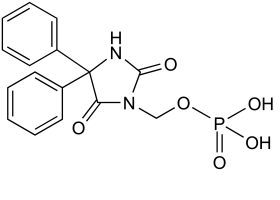THIS ANTICONVULSANT IS BETTER TOLERATED THAN PHENYTOIN.
Fosphenytoin (Cerebyx) was developed to reduce some of the problems associated with phenytoin (Dilantin), which is highly alkaline and can cause pain and burning at the injection site. Following parenteral administration, fosphenytoin, which is water-soluble and has a lower pH than phenytoin, is rapidly converted to phenytoin.
Mechanism of action: Fosphenytoin is believed to modulate voltage-dependent sodium and calcium channels of neurons, inhibit calcium flux across neuronal membranes, and enhance the sodium-potassium adenosine triphosphatase activity of neurons and glial cells.
Indications: Fosphenytoin is used to control status epilepticus and to prevent or control seizures during neurosurgery.
Dosage (adults): loading dose for status epilepticus-15 to 20 mg PE (phenytoin equivalent)/kg administered intravenously (I.V) at 100 to 150 mg PE/minute; maintenance dose for status epilepticus4 to 6 mg PE/kg/day intramuscularly (I.M.) or I.V.; loading dose for treatment or prophylaxis of seizures other than status epilepticus-10 to 20 mg PE/kg administered I.V. (at up to 150 mg PE/minute) or I.M.; initial daily maintenance dose-4 to 6 mg PE/kg/day
Pharmacokinetics:
onset of action, 15 minutes
peak effect, 3 hours
elimination half-life, 12 to 29 hours
Adverse effects: cardiovascular collapse, central nervous system depression, pruritus, paresthesia, nystagmus, dizziness, somnolence, ataxia, hypotension. Many of phenytoin's adverse effects also are associated with fosphenytoin, including potential acute hepatic effects, hematologic effects (such as thrombocytopenia and leukopenia), dermatologic effects (rash, Stevens-Johnson syndrome), hyperglycemia, and exacerbations of porphyria.
Interactions: Fosphenytoin and phenytoin share the same potential for drug interactions. Fosphenytoin can reduce the activity of many drugs, including warfarin and oral contraceptives. Fosphenytoin's action may be increased by the concurrent use of other drugs, including cimetidine, that inhibit enzymes that metabolize it or decreased by drugs such as carbamazepine that induce enzymes that metabolize it.
Contraindications and precautions: Fosphenytoin is contraindicated in patients known to be hypersensitive to phenytoin or other hydantoins and in patients with sinus bradycardia, sinoatrial block, second- and third-degree atriovenWular block, and Adams-Stokes syndrome. As with phenytoin, concomitant I.V. administration of a benzodiazepine may be needed to stop seizures in status epilepticus.
Nursing considerations:
All orders for fosphenytoin must contain the notation "PE." If you don't see this designation, clarify the order with the prescribing practitioner.
Frequently monitor vital signs during I.V. loading and continuously monitor cardiac rhythm.
When administered I.M., fosphenytoin generates concentrations of phenytoin that are similar to those of phenytoin administered orally, so I.M. fosphenytoin and oral phenytoin can be used interchangeably.
Before I.V. infusion, dilute fosphenytoin in 5% dextrose or 0.9% sodium chloride solution for injection to a concentration ranging from 1.5 to 25 mg PE/ml.
Take appropriate precautions for patients with seizures, such as padding side rails to prevent injury.
Fosphenytoin and phenytoin may harm a fetus and should be used during pregnancy only if the anticipated benefit justifies the risk to the fetus.
The safety of fosphenytoin in children hasn't been established.
Sources: "New Drugs, Part II," Nursing97, D. Hussar, June 1997; Physicians ' Desk Reference, 53rd edition, Medical Economics, 1999.
Copyright Springhouse Corporation Sep 1999
Provided by ProQuest Information and Learning Company. All rights Reserved



